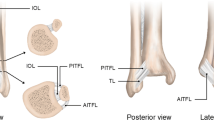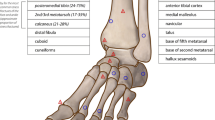Abstract
The purpose of this paper is to discuss the post-traumatic overload syndrome of the os trigonum as a possible cause of posterior ankle impingement and hindfoot pain. We have reviewed 19 athletes who were referred to our foot unit between 1995 and 2001 because of posterior ankle pain, and in whom a post-traumatic overload syndrome of os trigonum was diagnosed. All these patients were followed up over a period of 2 years. In 11 cases a chronic repetitive movements in forced plantar flexion was found. In the other eight cases the pain appeared to persist after a standard treatment of an ankle sprain in inversion plantar flexion. The diagnosis was based on clinical history, physical examination and X-rays that revealed a non-fused os trigonum. The confirmation of diagnosis was carried-out injecting local anaesthetic under fluoroscopic control. In all cases a corticosteroid injection as first line treatment was performed. In 6 cases a second injection was necessary to alleviate pain because incomplete recovery with the first injection. Three cases (16%) were recalcitrant to this treatment and in these three cases a surgical excision of the os trigonum was carried out. Our conclusion is that after some chronic athletic activity or an acute ankle sprain the os trigonum, if present, may undergo mechanical overload, remain undisrupted and become painful. Treatment by corticosteroid injection often resolves the problem.
Similar content being viewed by others
References
Blake RL, Lallas PJ, Ferguson H (1992) The os trigonum syndrome. A literature review. J Am Podiatr Med Assoc 82:154–161
Brodsky AE, Khalil MA (1986) Talar compression syndrome. Am J Sports Med 14:472–476
Bureau NJ, Cardinal E, Hobden R, Aubin R (2000) Posterior ankle impingement syndrome: MR imaging findings in patients. Radiology 215:497–503
Burkus JK, Sella EJ, Southwick WO (1984) Occult injuries of the talus diagnosed by bone scan and tomography. Foot Ankle 4:316–324
Cedell CA (1974) Rupture of the posterior talotibial ligament with avulsion of the bone fragment from the talus. Acta Orthop Scand 45:454–461
Cooper ME, Wolin PM (1999) Os trigonum syndrome with flexor hallucis longus tenosynovitis in a professional football referee. Med Sci Sports Exerc 31:493–496
Figueroa RT, Dozier T, Kalmar J (2001) Os trigonum syndrome. J La State Med Soc 153:402–405
Grant JCB (1958) Method of anatomy. Williams & Wilkins, Baltimore
Grogan DP, Walling AK, Ogden JA (1990) Anatomy of the os trigonum. J Pediatr Orthop 10:618–622
Hamilton WG (1982) Stenosing tenosynovitis of the flexor hallucis longus tendon and posterior impingement upon the os trigonum in ballet dancers. Foot Ankle 3:74–80
Hedrick MR, Mc Bride (1994) Posterior ankle impingement. Foot Ankle Int 15:2–8
Howse AJ (1982) Posterior block of the ankle joint in dancers. Foot Ankle 3:81–84
Johnson RP, Collier BD, Carrera GF (1984) The os trigonum syndrome: use of bone scan in the diagnosis. J Trauma 24:761–764
Karasick D, Schweitzer ME (1996) The os trigonum syndrome: imaging features. Am J Roentgenol 166:125–129
Marotta JJ, Micheli LJ (1992) Os trigonum impingement in dancers. Am J Sports Med 20:533–536
Massada JL (1991) Ankle overuse injuries in soccer players. Morphological adaptation of the talus in the anterior impingement. J Sports Med Phys Fitness 31:447–451
McDougall A (1955) The os trigonum. J Bone Joint Surg Br 37:257–265
Salyers SG, Fu FH (1989) Posterior ankle impingement syndrome in a ballet dancer. Orthop Consult 10:9–12
Stefko RM, Laverman WC, Heckman JD (1994) Tarsal tunnel syndrome caused by an unrecognised fracture of the posterior process of the talus (Cedell fracture). J Bone Joint Surg Am 76:116–118
Tachdjian MO (1990) Paediatric orthopaedics, 2nd edn. Saunders, Philadelphia
Tamburrini O, Porpiglia H, Barresi D, Bertucci B, Console D (1999) The role of magnetic resonance in the diagnosis of the os trigonum syndrome. Radiol Med (Torino) 98:462–467
Weinstein SI, Bonfiglio M (1975) Unusual accessory (bipartite) talus simulating fracture. J Bone Joint Surg Am 57:1161–1163
Wenig JA (1990) Os trigonum syndrome. J Am Podiatr Med Assoc 5:278–282
Author information
Authors and Affiliations
Corresponding author
Rights and permissions
About this article
Cite this article
Mouhsine, E., Crevoisier, X., Leyvraz, P.F. et al. Post-traumatic overload or acute syndrome of the os trigonum: a possible cause of posterior ankle impingement. Knee Surg Sports Traumatol Arthrosc 12, 250–253 (2004). https://doi.org/10.1007/s00167-003-0465-5
Received:
Accepted:
Published:
Issue Date:
DOI: https://doi.org/10.1007/s00167-003-0465-5




